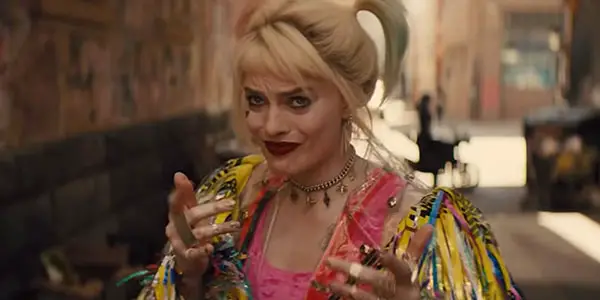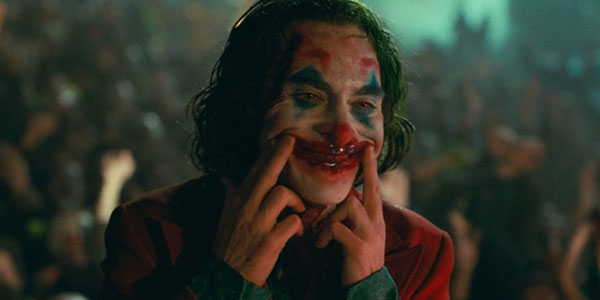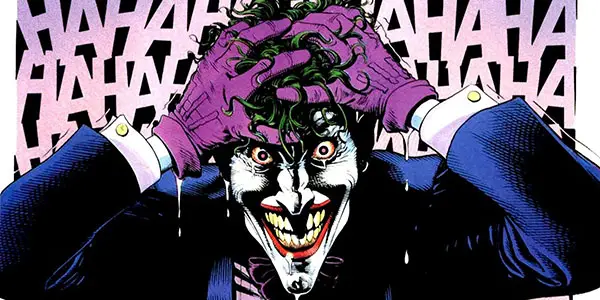The Joker’s Smile, Part 3: The Final Joke (For Now…)

Digital Media Program Coordinator and Professor at Southern Utah University…
With the release of Todd Phillip‘s newest film, the Joker has left behind his traditional role and evolved into a progressive symbol of protest. In this three-part exploration of everyone’s favorite “agent of chaos,” we’ll explore how the Clown Prince of Crime has become, thanks to audiences’ ever-evolving social conscience and critical eye, the newest champion of the 99%. In part 3, we explore the Joker’s full role-reversal, as well as that of his arch nemesis.
The Joker’s Expanded Universe
While this treatment is meant to be an exploration of live-action versions of the Joker throughout history, one would be remiss at this point not to mention Mark Hamill‘s masterful vocal interpretation, especially considering the fact that he has spent far longer portraying the character than any other actor. While his Joker has never been much for political commentary, the actor’s choice to release readings of President Donald Trump’s tweets using the Joker’s voice sends a very clear message: “The chilling clip was apparently inspired by comedy writer Matt Oswalt, who had suggested that Trump’s New Year’s Eve tweet sounded like something the Joker might say ‘before releasing a swarm of killer bees into Gotham.'”
While Todd Phillips‘ newest iteration of the Joker is delivering its own social commentary, one of the character’s most interesting colleagues is also getting the chance to attack society’s injustices in her own way. Originally created to play sidekick to the Joker in 1992’s Batman: The Animated Series, Harley Quinn is now on track to become a powerful and independent villain, much like the clown to which she has, until now at least, been fully devoted.
Margot Robbie‘s layered and fascinating take on the character deserves as much praise as we’ve heaped on the numerous interpretations of the Clown Prince himself, especially considering the monumental task before her. Just as Romero‘s initial take on the Joker has had a strong influence on each of the subsequent versions, so must Robbie‘s take on Quinn establish the foundation for future interpretations. This task alone would be enough to smother a less-capable actress, but the role also demands she find a way to step out of the Joker’s shadow in order to find an independent voice, and that she do so as a symbol of the growing #MeToo movement. A tall task to say the least, and while the future remains to be seen, Robbie is off to a fantastic start. For now, audiences will have to wait with bated breath for her next outing, Birds of Prey, due in theaters this year.

Still, political commentary and new characters are just a few examples of the various ideas the Joker has inspired. Throughout his innumerable depictions, Joker has gone from tragic and sympathetic to cruel evil incarnate, and everywhere in between. He’s inspired a plethora of written and visual work, and continues to find his way into virtually every storytelling genre, including literature, film, video games, and art, just to name a few. Such a well-traveled character is bound to leave a mark. Only time can tell us how the various precedents being established by the Joker will find their ultimate conclusions.
“Can you introduce me as Joker?”
One of the most interesting aspects of the Joker is his political commentary. This is made even more fascinating by its brevity, and by how rarely the commentary is offered. Still, whenever the Joker does offer an opinion on political or societal issues, we are put in the uncomfortable position of agreeing with him. The Joker is incredibly effective at punching holes in Batman’s philosophy, and in so doing, as discussed previously with the Dark Knight trilogy, he tends to also punch holes in the real-world society we support.
True, he tends to criticize democracy’s most difficult-to-solve problems, almost unfairly comparing the best facets of his preferred anarchy to the worst facets of societal democracy, but we are still left with the uncomfortable realization that a psychotic, murderous clown is able to so accurately pick apart the very foundations upon which civilization is built. And yet, we keep coming back for more. This, ultimately, is the greatest reason behind the Joker’s longevity as a template for modern villainy: when push comes to shove, he’s right:
While Batman may represent justice, he’s far from perfect, and at certain times his personality, logic, or moral compass just aren’t as appealing as the Joker’s. Batman is an avatar of order and control, sometimes straying into authoritarianism and even corruption. The Joker, meanwhile, is an avatar of chaos and madness, and over the years there have been more than a few times when his school of thought just made more sense than Batman’s.
While the comics, films, TV shows, and video games throughout the Batman universe consistently depict the Joker being “proven wrong” in his philosophies (it’s called Batman, after all), the morality scale in the real world has far more gray than many of us want to admit. This is yet another reason Phillips‘ film is so masterful: we’re finally getting a chance to explore some of the Joker’s philosophy without the overshadowing presence of the Dark Knight. As soon as Batman is placed in the periphery as a subplot rather than the main storyline, we’re left with a man so sympathetic that we wonder if, given the same circumstances, we too would end up locked away in Arkham.
ScreenRant’s Eric McAdams further writes: “The Joker adheres to an extremely cynical brand of nihilism, taking an absurdist view on mankind’s suffering. It’s hard to make a viewpoint like that resonate with viewers, but The Killing Joke succeeded, if only for a moment.” Now, we have another example of that success in Phillips‘ film, the newest story to shine a light on why the Joker’s philosophy deserves another look. This is not to say that the murderous escapades inspired by his “cynical brand of nihilism” are commendable, but the fact is, there are times when the world seems every bit the “terrible joke” Alan Moore‘s version of the Joker contends it is.
Murder and chaotic anarchy are clearly not the right way to go about campaigning for social change. But we also have to admit that using an enormous inheritance resulting from an inherently biased class system to dress up as a bat and wrench control out of the hands of the people by enforcing a brutal brand of vigilante justice to not-yet-convicted criminals is, to put it mildly, also not the right way to tackle the issues. As Justine Toh writes:
Batman fights to preserve the status quo, in effect protecting the structural inequality of the system that upholds his privilege. Under Batman’s tenure, democracy transmutes into authoritarianism… [E]mbedded in the reactionary politics of Batman Begins is recognition that Batman is part of the problem he attempts to eradicate in Gotham. (Toh, pp. 135-136)
Saving only their propensity for murder and violent crime, Batman’s villains have a more sympathetic moral cause than the Dark Knight himself. In fact, throughout the Caped Crusader’s entire anthology, the villains are responsible for instigating more social change than any of the characters upholding the status quo. These social changes are reactionary, yes, but at least they are enacted.
The only exception to this rule is Harvey Dent, whose personage is used to help clean up the streets at the end of The Dark Knight, but even this effort only succeeds thanks to a campaign based on lies. Since the release of the Dark Knight trilogy, real-world versions of these campaigns are increasingly the norm, and while Batman’s choice to deceive the people may have seemed justifiable or even commendable at the time of the film’s release, the reality of lie-based campaigns in the real world has come to show us otherwise, as psychologist Maria Konnikova warns:
When we are overwhelmed with false, or potentially false, statements, our brains pretty quickly become so overworked that we stop trying to sift through everything. It’s called cognitive load – our limited cognitive resources are overburdened… As it turns out, sheer repetition of the same lie can eventually mark it as true in our heads. It’s an effect known as illusory truth, first discovered in the 70s and most recently demonstrated with the rise of fake news.
The Final Joke: “I am the frightful man who laughs!”
Despite the incredible human cost of his many appearances since 1940, the Joker’s commitment to truth, uncomfortable or ugly as that truth may sometimes seem, has become more and more sympathetic in the eyes of audiences, thanks in large part to our growing experience with the “cost of lies” effectively explored in HBO’s Chernobyl. Another aspect at play, as previously mentioned, is the viewer’s evolving sympathetic eye, that sympathy borne of experience with the various civil rights and social movements of the last century. The fact is, a modern viewer watching Tim Burton‘s Batman Returns, for example, will take away a completely different message than the one perceived by its original 1992 audience.
Wherever the balance of credit for modern viewer conscientiousness lies between our negative experiences with political deception and our positive experience with progressive movements, one thing is for certain: the Joker is more popular than ever. He has long been considered the most despicable of Batman’s opponents. It’s fitting, therefore, that as the mirror rotates and social priorities change, he suddenly finds himself instead to be the most sympathetic. Of course, he himself hinted as much in The Dark Knight: “I’m not a monster. I’m just ahead of the curve.”

Aaron Eckhart‘s Harvey Dent proved prophetic when he said: “You either die a hero, or you live long enough to see yourself become the villain.” And here, at last, we see the Joker’s final joke. Batman has existed in the collective social conscience for 80 years, and finally, Dent’s prediction has come to pass. As social consciousness evolves, morals change. Batman, a symbol of social morality for so long, has, with Todd Phillips‘ film, become the villain. With the rise of Donald Trump and lie-based political and corporate practices, we finally see the danger Batman and characters like him can pose if we remain apathetic, allowing them to become “whatever [we] need [them] to be.”
Victor Hugo, writing as he sat in painful exile during the 1860s as punishment for his progressive views, could not have known what a comic book was, let alone that a villain borne of the genre would one day carry the torch he lit. While the familiar call: “I AM BATMAN!” will likely carry on as it always has, equally prescient, for now at least, is the call of a new cause: “I AM THE FRIGHTFUL MAN WHO LAUGHS!” (L’Homme qui rit [The Man Who Laughs] p. 511)
Silence, Peers of England! Judges, listen to my pleading! Oh, I conjure you, have pity. Pity for whom? Pity for yourselves. Who is in danger? Yourselves! Do you not see that you are in a balance, and that there is in one scale your power, and in the other your responsibility? …Are you selfish? Then save others. The destruction of the vessel cannot be a matter of indifference to any passenger. There can be no wreck for some that is not wreck for all. O believe it, the abyss yawns for all! …O my brothers below, I will tell them of your nakedness. I will rise up with a bundle of the people’s rags in my hand. I will shake off over the masters the misery of the slaves; and these favoured and arrogant ones shall no longer be able to escape the remembrance of the wretched, nor the princes the itch of the poor; and so much the worse, if it be the bite of vermin; and so much the better, if it awake the lions from their slumber… I am a monster, do you say? No! I am the people!…
I am the frightful man who laughs!

Ha! Ha! Ha! Ha! Ha!
Sources, Additional Reading
Golgowski, N. (2017, January 8). The Joker Reading A Trump Tweet Is Terrifying. Thanks, Mark Hamill! Retrieved from Huffpost: https://www.huffpost.com/entry/mark-hamill-the-joker-reads-trump-tweet_n_58726a33e4b099cdb0fd84ec.
Hugo, V. (1869). L’Homme qui rit (The Man Who Laughs).
Konnikova, M. (2017, January/February). Trump’s Lies vs. Your Brain. Retrieved from Politico: https://www.politico.com/magazine/story/2017/01/donald-trump-lies-liar-effect-brain-214658
McAdams, E. (2018, February 26). 16 Times the Joker Made Way More Sense than Batman. Retrieved from ScreenRant: https://screenrant.com/batman-joker-more-sense/.
Moore, A., & Bolland, B. (1988). The Killing Joke. DC Comics.
Roper Center. (2014, March 15). Public Opinion on Civil Rights: Reflections on the Civil Rights Act of 1964. Retrieved from Roper Center: https://ropercenter.cornell.edu/public-opinion-civil-rights-reflections-civil-rights-act-1964
Toh, J. (2010). The Tools and Toys of (the) War (on Terror): Consumer Desire, Military Fetish, and Regime Change in Batman Begins. In A. Froula, Reframing 9.11: Film, Popular Culture and the “War on Terror” (pp. 127-140). Continuum.
Joker was released in the U.S. on December 13, 2019. For international release dates, see this page.
https://www.youtube.com/watch?v=-_DJEzZk2pcDoes content like this matter to you?
Become a Member and support film journalism. Unlock access to all of Film Inquiry`s great articles. Join a community of like-minded readers who are passionate about cinema - get access to our private members Network, give back to independent filmmakers, and more.
Digital Media Program Coordinator and Professor at Southern Utah University and Southwest Technical College; M.Ed.; Author at Labyrinth Learning and Film Inquiry. Passionate educator of film theory and history. World-class nerd with a wide array of interests and a deep love for many different fandoms.













